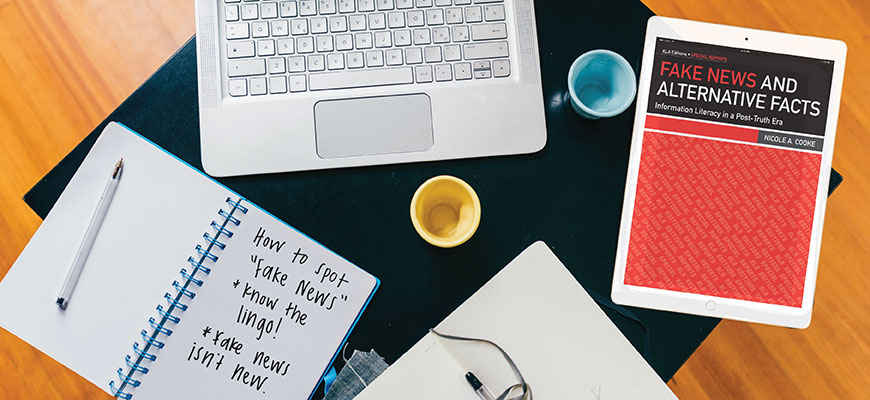
7 things to know in the fight against 'fake news'
Posted on: December 3, 2020; Updated on: December 3, 2020
By Rebekah Friedman, rebekahb@mailbox.sc.edu, 803-576-7270
If you’ve ever come across a story or image or video online and thought to yourself, “There’s no way this is real,” there’s a good chance you were right. Fake news is a growing threat, and advances in technology are making it harder to spot.
In November, two researchers in the College of Information and Communications sat down for “Can You Spot Fake News,” a discussion about what it is, how it works and what can be done to address it.
Nicole Cooke is the Augusta Baker Chair in the School of Information Science and author of Fake News and Alternative Facts: Information Literacy in a Post-Truth Era. Last spring, she taught a graduate course on fake news, and in spring 2021, she’ll teach a news literacy class open to all UofSC undergraduates.
Denetra Walker, a doctoral student in the School of Journalism and Mass Communications, has studied the spread of fake news across social media and is exploring how journalists are working to combat it.
Here are seven key takeaways from their conversation:
1. Know the lingo.
“Fake news is the latest moniker that we have applied to misinformation and disinformation,” Cooke says.
Misinformation is false information that is spread, but not necessarily on purpose — think misleading headlines or typos that change the context of stories. Disinformation, on the other hand, is purposely created to mislead and deceive. This can include deepfakes — videos created with sophisticated artificial intelligence — and shallowfakes, videos that are real but misrepresented.
Then there’s malinformation — a newer term for information that’s intended to be harmful, such as doxing and revenge porn. “This is information that can actually be dangerous,” Cooke says.
2. Fake news isn’t new.
It might seem like “fake news” entered the lexicon in 2016, but Cooke says it’s actually been around for much longer than that — as far back as the late 1800s. And while the terminology has varied, the practice of presenting false information as news has remained a constant.
“What the difference is now is this idea of digital media and how fast information goes around,” she says.
3. Sometimes there’s a kernel of truth.
Fake news is often based at least partially in reality, and weaving truth into the lies is what makes false or misleading stories so appealing.
“A lot of times that disinformation is a little shinier,” Walker says.
Cooke agrees, “There’s always some type of plausibility or feasibility, and that’s what makes it hard to get past the mis/dis, as I call it.” She adds that peeling back the layers can help reveal the pieces of misinformation and disinformation.
4. Repetition makes it harder to combat.
Cooke studies a phenomenon known as repetition theory — the idea that the more a lie is repeated, the more likely people are to believe it, sometimes even subconsciously. And once people have bought into the lie, changing their minds is a challenge.
5. Skepticism is healthy.
In 2018, actor Jordan Peele released an altered video of President Barack Obama to raise awareness of deepfake technology. The convincing video made headlines, but for viewers familiar with Obama’s mannerisms, something seemed … off.
“Knowing that larger context would give you that gut feeling,” Cooke says. “If you don’t have that larger knowledge, you’re not going to question it. We want people to have a healthy level of skepticism and dig a little deeper.”
6. Spotting it has gotten harder.
In the early days of the internet, identifying a suspicious website was easy — poor design was a dead giveaway, and users were advised that URLs ending in “.edu” or “.org” were more trustworthy than a “.com.” But now, high quality web content can be created in a matter of seconds.
The rise of the content producer — and the seemingly endless content they create — has contributed to another problem: filter bubbles.
“You can so carefully curate the information that you’re seeing that you don’t actually have to see information that you disagree with,” Cooke says. “That starts moving into what we call truth decay because it’s so carefully curated you’re missing so much more.”
7. What you can do.
The first step, Cooke says, is being aware of where you’re getting your information and asking whether you’re going outside your bubble. Her students create a 24-hour news log as a way to begin that conversation.
From there, two techniques can help verify information: triangulation and lateral reading. Triangulation means confirming a story in at least three news sources. Lateral reading involves opening up new tabs in your browser to investigate sites or claims as you encounter them.
To prevent inadvertently spreading false information, Cooke recommends holding off on posting until you’re sure it’s real.
The onus is also on educators to teach students valuable news literacy skills.
“We need to arm students with the type of knowledge to be able to spot it because maybe they could plant a seed with a family member or a friend or maybe they can potentially stop spreading it in an unintentional way,” Walker says.
Share this Story! Let friends in your social network know what you are reading about